Firstly, if you want to get the best out of your trip you should aim to get out on ice somewhere in the UK beforehand, although this can prove to be difficult. Also, consider hiring a Mountaineering Instructor Certificate (MIC) http://www.mountain-training.org/mountaineering/other/find-a-leader to get you seconding some routes and practicing placing ice screws; Scotland is definitely your best bet for this!
So, let’s tackle the first important question: “When is the best time to go?’ December to April is definitely the optimum period and coincides with UK wintertime, generally has the best conditions with temperatures ranging from -5 to -21 during winter 2017. In an ideal world, you will be able to bag some winter climbs in the UK before heading out to Norway, ready to climb some steep ice.
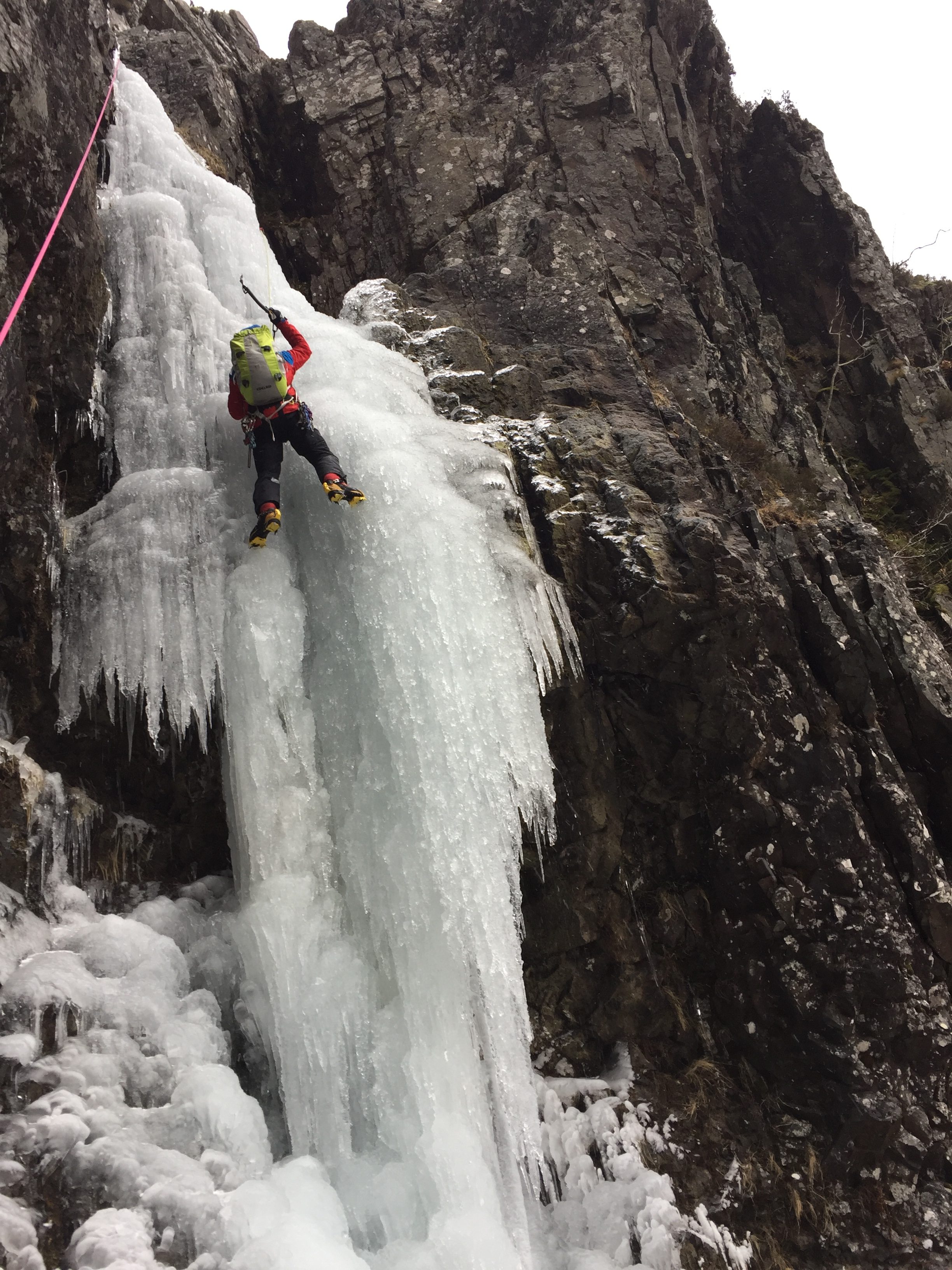
Winter preparation in Scotland Feb 2018 – “Blue Ribband WI5” courtesy of the The Beast from the East
Preparation & Fitness
In general a basic level of fitness (eg someone who engages in activities such as walking, jogging, indoor climbing or gym sessions a couple of times a week) is sufficient enough to enjoy the demands of several days ice climbing. Indoor ice climbing is great preparation and will help to build strength and general fitness, and will improve your technique too. You can hire ice climbing equipment from indoor venues in the UK, and this is the perfect opportunity to put it to the test before you go out and spend a lot of hard earned money on expensive kit such as: crampons (mono or dual point?) try them both, which do you prefer? My personal preference is mono points for steep ice and dual for mixed climbing) suitably curved shafted axes for steep ice (leashes or leash less?) Again a personal choice that comes with climbing routes. My recommendation for axes for steep ice is Singing Rock’s bandits. Ice climbing indoors will help to improve your technique whilst being on the safety of a top rope and is good practice for handling rope with gloves on for belaying if you’ve never tried this before. It can also help to ensure you have the most suitable clothing: thinner dexterous gloves for climbing, thicker gloves and jacket for belaying. Indoors you will use the rope installed at the venue, obviously you will need to take your own for your trip. I recommend a dry treated sixty metre single rope for most crags in Rjukan even up to leading Water Ice (WI3) routes and don’t forget the ice screws, make sure you have at least eight between you and your climbing partner, of various lengths. In terms of boots, you’ll need a B3 boot with a stiff sole and insulation to keep your feet warm all day, I recommend AKU’s Serai GTX a great boot that is a combination of lightweight and a technical mountaineering boot that does exactly what it says on the box..
Getting There
As a major ice-climbing destination during the winter months, and notably one of the world’s greatest ice climbing venues with its roadside ice, Norway is a great destination and is only a ninety-minute flight from the UK. It can be done on a budget with some careful, upfront planning; I recommend a group size of four, so you can share a car. Book your flights several months in advance! For our last trip we used a budget Irish airway and paid less than eighty pounds return. By checking in only two holdalls, for four people, we kept the cost of the flight down, and also avoided the extra baggage fees. If you don’t mind sharing, there is no need for every person in the group to take their own ice axes. As generally, only one climber climbs at any given time on single pitch venues: it’s surprising how much extra weight and space you can save! During a recent visit, we used a self-catering log cabin in the village of Antra, Telemark, which is an approximate three hour drive from Oslo, Torp airport, and about twenty minutes’ drive to the nearest crag; Krokan in our case. To get there, we hired an estate car from the airport, booked in advance for sixty pounds per day between the four of us. Note, all vehicles come with winter tyres to help you navigate the snow covered roads.
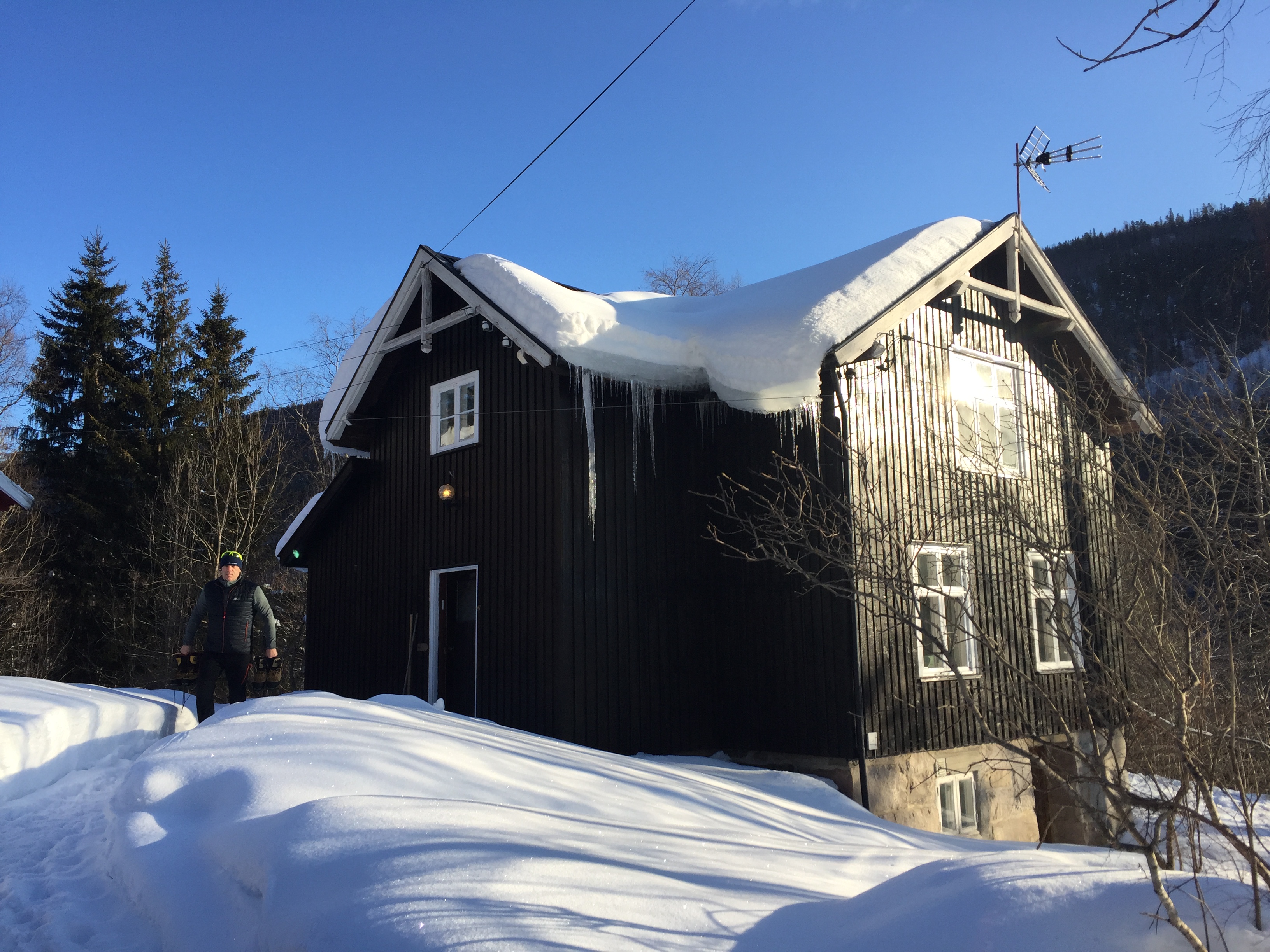
Typical log cabin style accommodation in Antra
What to Expect
Temperatures are consistently low, depending on the time of year, you can expect anything between minus five and minus fifteen and there is normally minimal wind chill like you get in the UK, certainly when you’re in the canyons climbing. If you’ve planned your accommodation well, you should be rewarded with just a short drive and very short walk in. Most of the crags in Rjukan have both single pitch and multi pitch routes of all grades so this should cater for any difference in skills within your group. You need to be familiar with setting up top rope anchors for rigging single pitch climbs. If you’re not familiar with this it is worth looking up a Rock Climbing Instructor (RCI) or Mountaineering Instructor Award (MIA) holder to go through some basic rigging before your trip. It is certainly worth bringing some spare tat, extra slings and mallions to facilitate this, the majority of routes we rigged made use of sturdy trees above the crags with the odd ice screw or ice thread for redirects where required. If you plan your dates accordingly you could tie them in with the annual ice climbing festival that takes place in Rjukan itself, normally the last weekend in February, see link for more info – https://www.visitrjukan.com/en/what-s-on/rjukan-icefestival
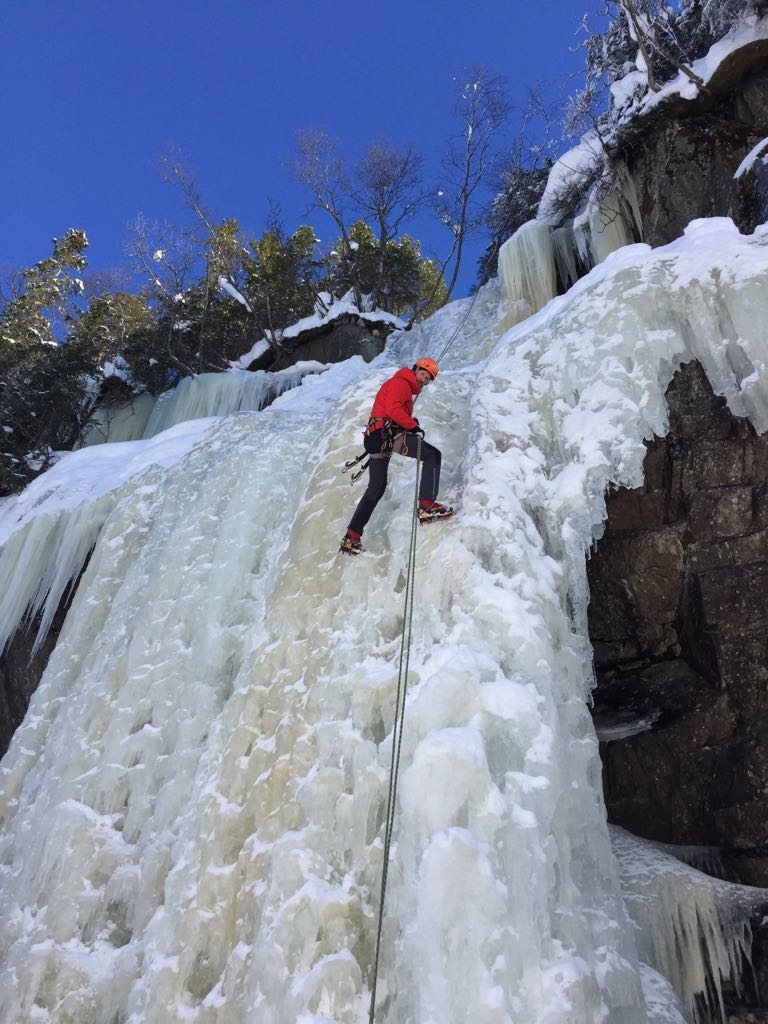
Rigging top ropes from the top of the crag – Bullen area
Something else to consider
There are very few pubs in Rjukan itself, and it is quite rare to find alcohol in the supermarkets. So, if this is a requirement, then it is advisable to purchase alcohol before you leave the airport. Also supermarket prices are a little higher than the UK; but with some creative thinking you can rustle up some good quality evening meals for your group to keep you going all day and snacks for the crag .
Where to Go
The actual ice climbing venues are well documented with good route descriptions and how to find them in the Heavy Water Rockfax guide to Rjukan, it provides information on over one hundred and seventy routes including mixed climbing routes. Most of the areas below are all within twenty kilometres of Rjukan town itself which is located one hundred and seventy five kilometres west of Oslo and is on the main road number Thirty Seven in a deep narrow valley. In general the town does not really see sunlight for up to four months of the year.
Krokan – This is a great venue, with an abundance of routes ranging from ten metres to forty metres in height. The later in the season you go the more sunlight you get here also, which means you can actually climb on ice with the sun on your back! Routes here range from WI3 to WI5 and some mixed route M4 to M10 if that’s your preference. It’s approximately seven hundred metres higher than the town itself and gets the sunlight from early morning.
We were lucky enough to get sunshine all day on our visit in March, it was still cold at minus thirteen Celsius. There is a skidoo track that leads over a bridge and provides access to the top of the routes. You can rig top ropes from here and abseil down into the gorge to inspect the ice or return to the base of the climb via the skidoo track. During our visit the ice was well formed and plentiful, hard but not too brittle. We started on the main and most popular route Bullen and another adjacent line which are both graded at WI3 before moving to the right hand end of the crag to climb Jomfrua WI4 (left hand & right hand variants)and the steep Fyrstikka WI5 which proved to be very popular with the group.
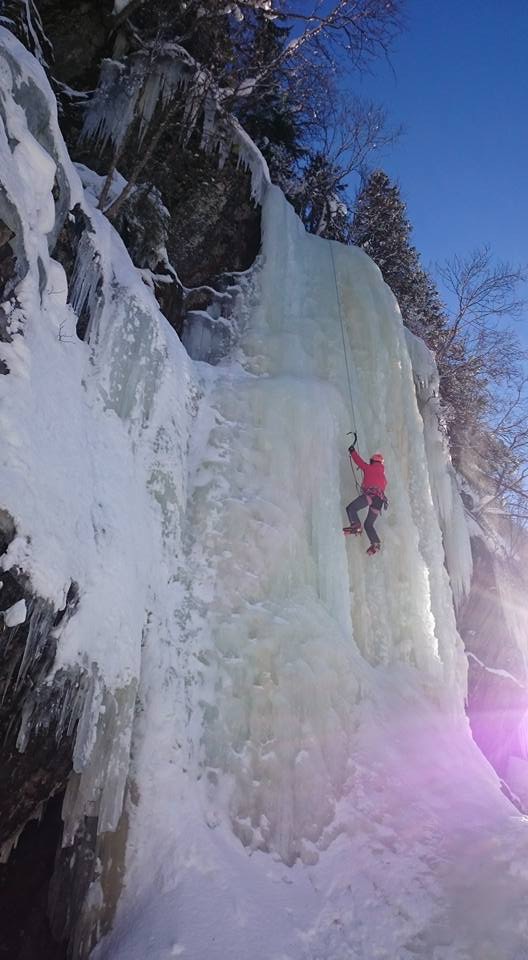
Fyrstikka WI5 – Krokan area
Ozzimosis – This is a great area for beginners with grades ranging from WI2 – WI4 and suitable for climbers looking to get their first lead ice climb. This crag is out of direct sunlight and as a result stays in good condition. We headed here on our second day as some of the team were looking for their first winter leads and it made for a nice progression from the previous day. We successfully got leads on a few routes to include Arsdagen WI2, Julevask WI2 and Juledusj WI3, we also climbed Svada variant WI4 on top rope as a warm up.
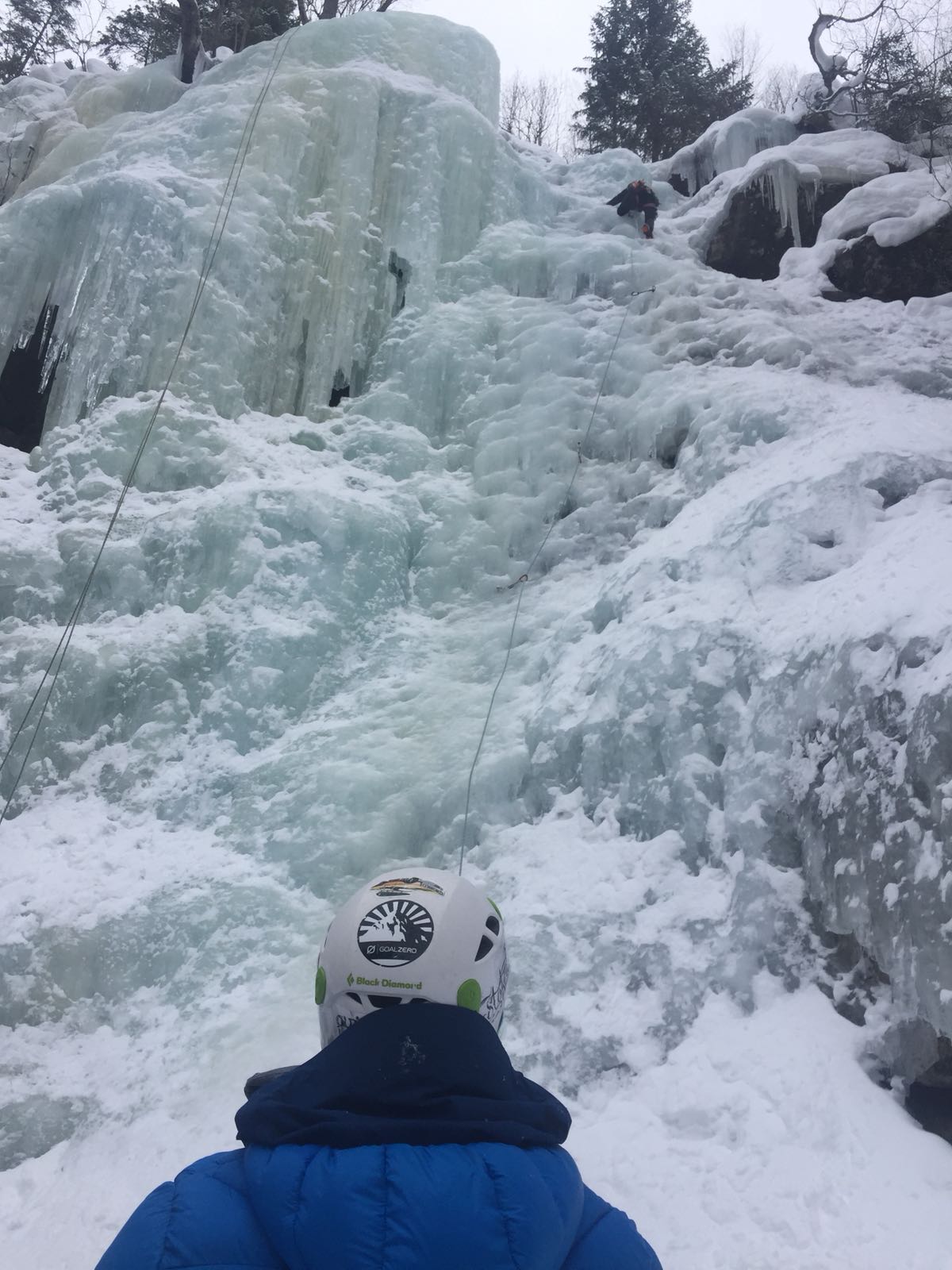
Typical roadside icefall and great venue for beginners in Ozzimossis
Gausta – This is higher up the valley at about one thousand metres and has a twenty minute walk in from the road to the base of the climbs, all routes here are WI3 and are a good alternative venue to the busy hotspots.
We headed here on our third day as it was a mere ten minute drive from our log cabin. Unfortunately for us there had been a lot of snowfall overnight making the approach hard work as the snow was very deep and us having to make fresh tracks. Unfortunately for us the routes were also covered in deep snow making climbing there impracticable.
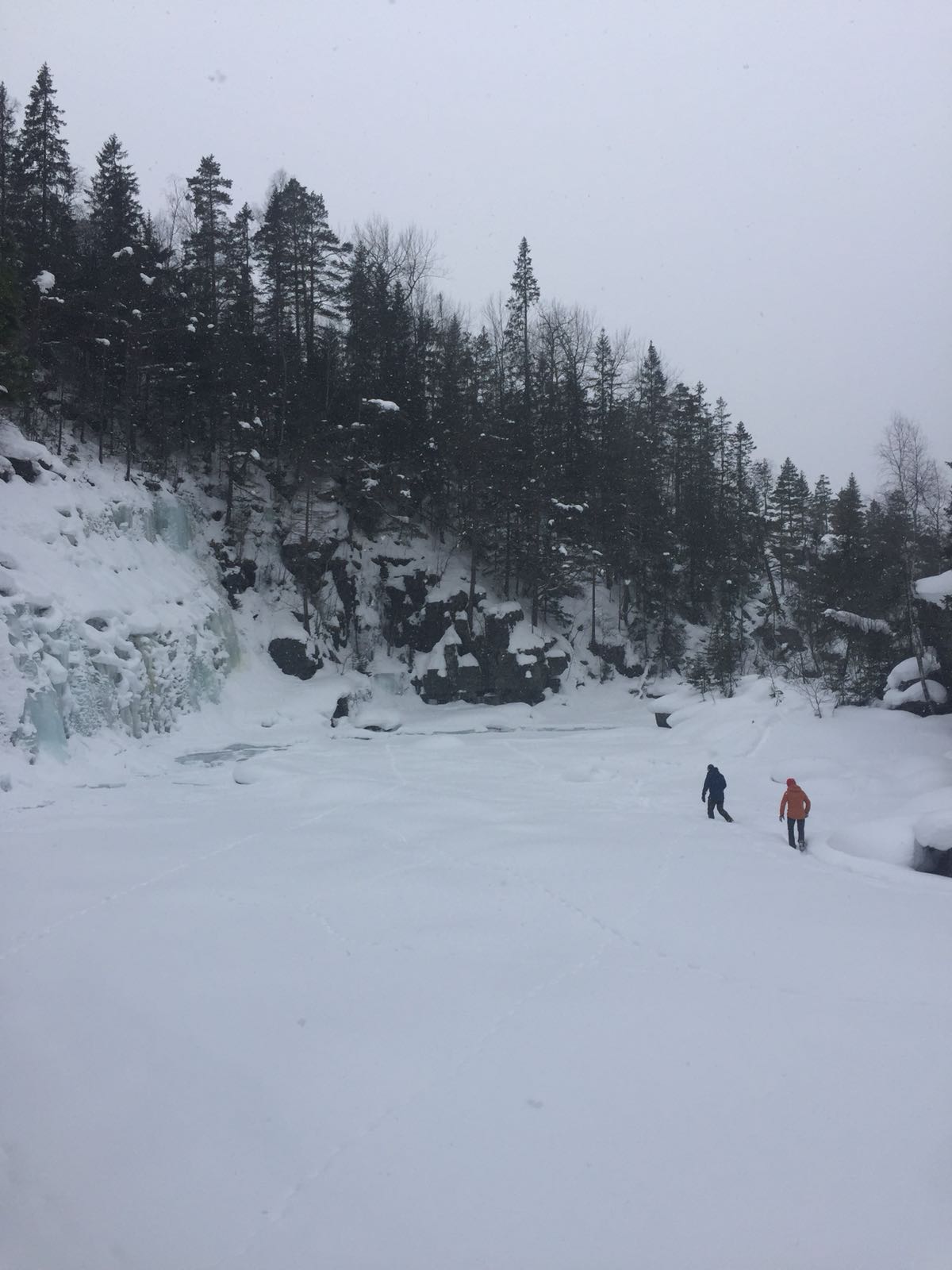
Disappointingly too much snow on the routes! – Gausta
Schoolroom Area – It’s not in the Rockfax guidebook but it’s a perfect venue for training, topos are available online and once again the grades here are very amenable.
There are numerous other venues to contemplate for a return trip once you have got your technique right and look to progress to multi pitch climbing: The Upper Gorge, Vemork Bridge, Rjukan Centre, Gausta area, Svadde, Bolgen and Kong Vinter to name just a few.
What Else is on offer?
If you decide that you need a break from ice climbing, Rjukan town itself is worth a visit. It’s a UNESCO World Heritage Site located close to the Hardangervidda National Park and lies in a deep valley and during the six months of winter, the surrounding mountains cast a shadow over the town even at midday. In 2013 however, an innovative project changed this, the project involved the placement of huge mirrors above the town to reflect sunlight during the sun-starved winter months. Rjukan – or at least, a small but vital part of Rjukan – is no longer stuck in the shadow. During World War II, Vemork in Rjukan was one of the few places in Europe that made heavy water, an important ingredient in the first nuclear bombs. The facility was sabotaged by Norwegian resistance fighters (The Heroes of Telemark) which prevented Germany from developing the atom bomb. This operation made Vemork the centre of one of the most important and daring sabotage missions during the war. At the Norwegian Industrial Workers’ Museum at Vemork, you can learn more about Rjukan’s exciting wartime history. Failing that you could just go to the indoor swimming pool and relax with a steam bath & sauna. For those feeling energetic, maybe a visit to what is claimed to be the most beautiful mountain in Norway, Gaustatoppen, which towers majestically above the town of Rjukan at an altitude of 1,883 metres. Around thirty thousand people make the trip up to the summit every year to enjoy the fantastic views from the top. On a clear day, you can see all the way south to the coast and east to Sweden. No matter what the weather is like, you can still buy a cup of coffee, waffles and food at the Tourist Association’s one hundred year old stone cabin on the summit. You can even pick your own stone from the piles around the summit and get it stamped to prove that you climbed the mountain. For those keen on skiing, Gustablikk Ski Centre is fifteen minutes from Rjukan and has twelve ski lifts and thirty slopes to keep you occupied with the longest run at three thousand five hundred metres.
If all else fails you could just go out, find some roadside ice and practice constructing Abalakov threads and test how strong they really are. I can pretty much guarantee it’s not something you will ever get to do on the side of the road back in the UK and you will get a few strange looks by drivers as they drive by…

![]()


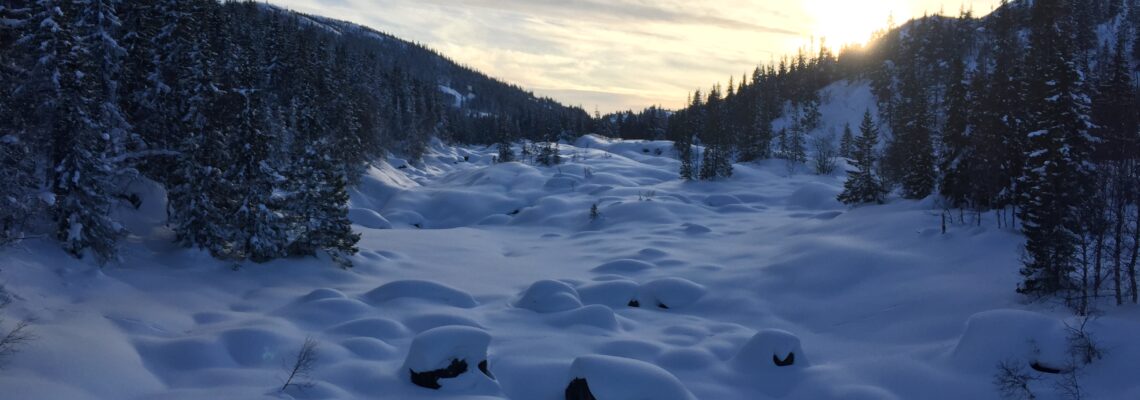
Leave a Reply